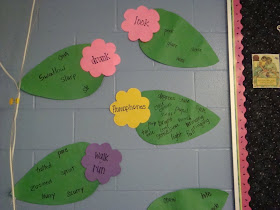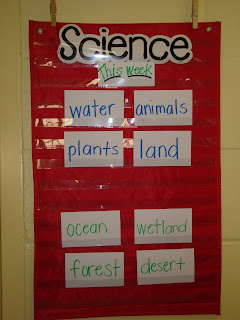That is actually the most typical visualization, however it is only one type of word wall. The mental image you created of a spelling word wall is the most common word wall tool in the primary school used as a visual reference for students of high frequency words. The spelling word wall is used to support the growing number of words students should be able to read and spell correctly. They are introduced gradually with explicit instruction before being added to the wall. When done well, activities are built around the word wall offering extended exposure and chances for repeated practice are consistent until the words are mastered with great efficiency. The other type of spelling wall I envision is one centered around spelling patterns... -at, -ike, -ake, etc... Below are examples of some of the spelling word walls displayed and used in classrooms at Chets Creek.
Spelling Word Walls





A second type of word wall you would encounter in our classrooms is a writing word wall. Most commonly, our writing word walls are displayed as a tool for students to use during their Writers' Workshop to enhance the level of vocabulary used while writing stories. The typical writing word wall includes simple words, like said, that can be replaced with more descriptive or sophisticated terms, like squealed or whispered. In addition, as children learn about sentence structure and offering sentence variety in their writing, they might find useful words displayed by part of speech. On several occasions, I've also seen students with independent word walls on the back of their writing folders. These words are individualized and typically words most often misspelled in that student's writing. The personal word wall is used throughout the writing process.
Writing Word Walls





Reading Vocabulary is another universal word wall used in CCE classrooms. In Kindergarten through Third Grade, we use Scholastic's Text Talk series for explicit vocabulary instruction through children's literature read alouds. Several words per book are introduced with explicit instruction and activities using the words are taught. Furthermore, you will find reading vocabulary word walls that are built as students are introduced to words in the context of other reading. For example, one of the word walls below is from the chapter book, Because of Winn Dixie.
Reading Vocabulary Word Walls






Content Vocabulary Word Walls in Math, Science, and Social Studies are frequently displayed in CCE classrooms in K-Grade 5, too. Just like spelling, writing, and reading vocabulary word walls, content word walls are used not only as a display but as a reference tool, too. The primary goal is for student mastery and understanding of each of the terms. Some content word walls have the definition displayed with the word on the front of a card, others have the term printed on the back and are secured with velcro to a chart or stored inside a pocket chart making them easily removable by students. Also, other displays are a list of the words that teachers use for specific activities. You can see a few examples of each type below.
Math Word Walls



Science Word Walls




Social Studies Word Walls


 Print rich classrooms full of resources including word walls are important to promote student learning and achievement. Word walls make words visible, usable, and accessible to our learners. I'd love to get a comment about the way you use word walls in your own classroom.
Print rich classrooms full of resources including word walls are important to promote student learning and achievement. Word walls make words visible, usable, and accessible to our learners. I'd love to get a comment about the way you use word walls in your own classroom.
I love what you folks do. Merry Christmas, Happy New Year! Keep working hard. Your professionalism reflects positively on us all.
ReplyDeleteSuzanne: It is extremely evident that you are not a paper-pushing instructional coach at CCE. You are in teacher's classrooms, you are at round-table discussions with our teachers, your camera appears in the oddest places to document the work that is being done at school...
ReplyDeleteI'm not sure how you manage it all, but you're doing a fabulous job of giving teachers what they need to move their work forward with students.
I wish you had been my classroom teacher when I was in elementary school. I am certain I would have been better prepared for the middle years and beyond.
I appreciate your tenacity, girl!
Awesome Blog!
ReplyDeleteIf you're at all interested in music, then you can visit mine at http://notesdaily.wordpress.com/
Thank you so much for sharing!
ReplyDeleteI have to agree with Dee Dee. As a Math Coach in Toronto, I also find that the teachers I work with really appreciate it when my "coaching' is grounded in actual classroom and student work!
Awesome Word Walls at CCE!
ReplyDeleteI love your blog, and I am officially a fan of CCE! I'm a third grade teacher from Ohio, but I told my husband that we're moving to Florida so that I can apply at CCE! Haha! It's very apparent that you have a very committed, hardworking, collaborative staff. I really admire what you have all accomplished. I sometimes feel like I teach on my own little island. I am in awe of how much you all work together and share! Thanks for sharing your practices with the rest of us!
ReplyDeleteLove these pics. Every type of word wall I see gives me one more that I want to use with my online reading students! I'm constantly amazed by the cleverness of teachers. :D Great stuff!
ReplyDelete